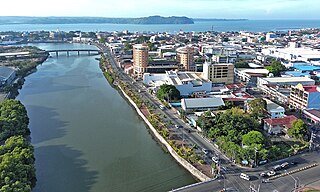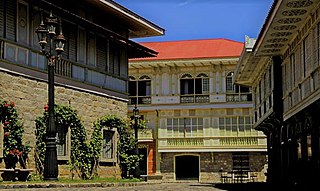
Iloilo, also called Iloilo Province, officially the Province of Iloilo, is a province in the Philippines located in the Western Visayas region. Its capital and largest city is Iloilo City, the regional center of Western Visayas and politically independent from the province. Iloilo occupies the southeast portion of the Visayan island of Panay and is bordered by the province of Antique to the west, Capiz to the north, the Jintotolo Channel to the northeast, the Guimaras Strait to the east, and the Iloilo Strait and Panay Gulf to the southwest.

Bacolod, officially the City of Bacolod, is a 1st class highly urbanized city in the Negros Island Region in the Philippines. With a total of 600,783 inhabitants as of the 2020 census, it is the most populous city in the Negros Island Region and the second most populous city in the entire Visayas after Cebu City.

Beaux-Arts architecture was the academic architectural style taught at the École des Beaux-Arts in Paris, particularly from the 1830s to the end of the 19th century. It drew upon the principles of French neoclassicism, but also incorporated Renaissance and Baroque elements, and used modern materials, such as iron and glass, and later, steel. It was an important style and enormous influence in Europe and the Americas through the end of the 19th century, and into the 20th, particularly for institutional and public buildings.

Iloilo City, officially the City of Iloilo, is a 1st class highly urbanized city in the Western Visayas region of the Philippines, located on the southeastern coast of the island of Panay. According to the 2020 census, Iloilo City has a population of 457,626 people, making it the most populous city in Western Visayas. For the metropolitan area, the total population is 1,007,945 people.

Mandurriao Airport, also known as Iloilo Airport during its operation, was an airport that served the area of Iloilo City and the province of Iloilo in the Philippines. The airport was located 5 kilometres (3.1 mi) northwest of downtown Iloilo City in the district of Mandurriao. It was the fourth-busiest airport overall and the busiest domestic airport in the Philippines, accommodating over 700,000 passengers and over 5,000 tons of cargo in 2005. During the construction of the new Iloilo International Airport, it was also known as Iloilo-Mandurriao Airport.

Jaro is a district in Iloilo City, Philippines, located in Iloilo province, on Panay Island in the Western Visayas region. It is the largest district in terms of both geographical area and population, with 130,700 people according to the 2020 census. It is the seat of the Roman Catholic Archdiocese of Jaro, which encompasses the provinces of Iloilo, Guimaras, Antique, and Negros Occidental, as well as the center of the Candelaria devotion in the Philippines.

Juan Marcos Arellano y de Guzmán, or Juan M. Arellano, was a Filipino architect, best known for Manila's Metropolitan Theater (1935), Legislative Building, the Manila Central Post Office Building (1926), the Rizal Memorial Sports Complex (1934), the Central Student Church, the old Jaro Municipal Hall (1934) and the Old Iloilo City Hall (1935) in Iloilo, the Negros Occidental Provincial Capitol (1936), the Cebu Provincial Capitol (1937), Dumaguete Presidencia (1937), the Bank of the Philippine Islands Cebu Main Branch (1940), Misamis Occidental Provincial Capitol Building (1935), Cotabato Municipal Hall (1940) and the Jones Bridge during the pre-war era.

Iloilo City Proper, also known as Downtown Iloilo or simply Iloilo among locals, is an administrative district in Iloilo City, Philippines, located on the southeastern coast of the island of Panay in the Western Visayas region. It serves as the civic center of the city and province of Iloilo, hosting the seat of city and provincial governments, as well as various local, provincial, and regional government offices. According to the 2020 census, it has a population of 46,350 people.

Iloilo International Airport is the main international airport serving Iloilo City and its metropolitan area, as well as the rest of Iloilo province in the Western Visayas region of the Philippines. It is the fifth-busiest airport in the Philippines and is located in the municipality of Cabatuan, Iloilo, approximately 24 kilometers (15 mi) northwest of Iloilo City proper, on a 188-hectare (460-acre) site.

The architecture of the Philippines reflects the historical and cultural traditions in the country. Most prominent historic structures in the archipelago are influenced by Austronesian and American architectures.

The Cebu Provincial Capitol is the seat of the provincial government of Cebu in the Philippines. Located at the north end of Osmeña Boulevard in Cebu City, it was designed by Juan M. Arellano, a Filipino architect best known for the Manila Metropolitan Theater (1935), the Legislative Building, and the Manila Central Post Office (1926). An inscription on the central concave portion of its façade reads, "The authority of the government emanates from the people. Erected A.D. MCMXXXVII."

William Edward Parsons was an architect and city planner known for his work in the Philippines during the early period of American colonial period. He was a consulting architect to the Insular Government of the Philippine Islands from 1905 to 1914, and designed various structures, most notably the Gabaldon school buildings.

Casa Real is one of the oldest public buildings and served as the provincial seat of government of Lingayen, Pangasinan, in the Philippines during the Spanish colonial period. It was where the alcalde mayor held office as the provincial governor and the judge of the Court of First Instance. It was declared a National Landmark by the National Historical Commission of the Philippines and noted it as "an outstanding and unique example of civil architecture from the Spanish and American colonial periods". Local offices that were housed by the building abandoned it when Typhoon "Cosme" ripped off its roof in 2008. Since 2023, the building houses the Banaan Pangasinan Provincial Museum.

The Governor of Iloilo is the local chief executive of the Philippine province of Iloilo. The governor holds office at the Iloilo Provincial Capitol located at Bonifacio Drive, Iloilo City. Like all local government heads in the Philippines, the governor is elected via popular vote, and may not be elected for a fourth consecutive term. In case of death, resignation or incapacity, the vice governor becomes the governor. Along with the governors of Aklan, Antique, Capiz, andGuimaras, he sits in the Regional Development Council of the Western Visayas Region.

The Iloilo Customs House is a historical building in Iloilo City, Philippines. It was built in 1916 to a design by American architect Ralph Harrington Doane, then Consulting Architect of the Bureau of Public Works in the Philippine Islands. Among the three American-era customs houses in the Philippines, it is the second largest and second oldest. The building is located at Muelle Loney Street and Aduana Street along the Iloilo River and still houses the offices of the Bureau of Customs and the Bureau of Immigration in Iloilo City.

The Casa Real de Iloilo, also known as the Old Iloilo Provincial Capitol, was the seat of the provincial government of Iloilo in the Philippines since the Spanish colonial period until 2006. It also served as the residence of the alcalde-mayor, presidente municipal, or governor, who held the highest authority as the Spanish official in Iloilo during the period.

The Iloilo City Hall is the official seat of government of the City of Iloilo, Philippines, located in Plaza Libertad, Iloilo City Proper. It is where the Mayor of Iloilo City holds office and the chambers of the Iloilo City Council. It also hosts several offices under the Iloilo City Government.

Museo Iloilo is a provincial museum located near the Iloilo Provincial Capitol in Iloilo City, Philippines. It is the first government-sponsored museum in the Philippines outside of Metro Manila. The museum houses a collection of Iloilo's cultural heritage.

Arroyo Fountain is a historical landmark in Iloilo City, Philippines. It is located in front of Casa Real de Iloilo, or the Old Iloilo Provincial Capitol, in Iloilo City Proper. It was named after Senator José María Arroyo, who authored the law, Republic Act No. 3222, that established the then Iloilo Metropolitan Waterworks in 1925.

Iloilo City is a conglomeration of former cities and towns in the Philippines, which are now the geographical or administrative districts (boroughs) composed of seven: Arevalo, City Proper, Jaro, La Paz, Lapuz, Mandurriao, and Molo. All administrative districts are divisions of the lone congressional district of Iloilo City, and each is composed of barangays (barrios), with a total of 180 city barangays.























